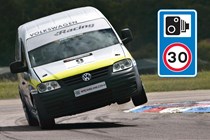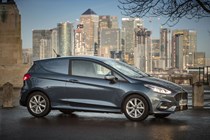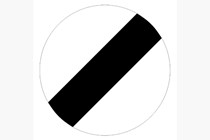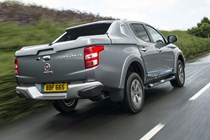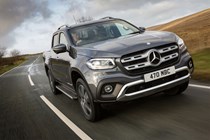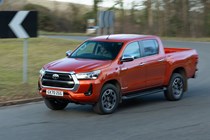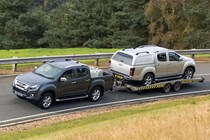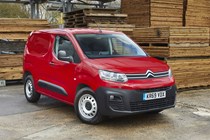Do you know your van speed limits? From what we see on Facebook, forums and other social media, people are often surprised to learn that vans, and some pickup trucks, can’t be driven as fast as cars – and sometimes they only find out when they receive a fine in the post.
It’s important to know the difference between car and van speed limits because the speed limit signs you see on the road only apply rigidly to cars. Van speed limits are often lower. And with courts able to fine you up to £2,500 as well as apply points on your licence that might result in a driving ban, the impact on your business for getting the speed wrong could be severe.
If you’re caught speeding in a van you could well be treated more harshly than if you were speeding in a car, too. Plus, speed is a major contributor to road accidents, so fines and points will also increase your van insurance as insurance companies will view you as a bigger risk. Rushing between jobs could end up costing you a lot more than just a few minutes of time.
To help you stay on the right side of the law, this page will take you through all the UK van speed limits. We’ll also explain how and on what types of roads they differ from cars, and cover the kinds of light commercial vehicles (LCVs) van speed limits apply to.
Campervan speed limits we cover separately, though you will find their basic speed limits listed below.
What is the speed limit in a van?
Drive lots of different types of van? Then the basic rule of thumb for light commercial vehicle speed limits is that up to 50mph they are the same as cars. But above this they are often 10mph slower.
Van speed limits:
- > Speed limit in built-up areas (such as towns and cities): 30mph – the same as a car
- > Single carriageway speed limit (with the National Speed Limit sign): 50mph – 10mph less than a car
- > Dual carriageway speed limit: 60mph – 10mph less than a car
- > Motorway speed limit: 70mph – the same as a car
These limits are subject to further local restrictions, according to the posted speed limit signs – so you may find dual carriageways with 40mph limits, 20mph zones in towns, and so on.
Many motorways have variable limits now, too. On the latest ‘smart’ motorways, changes in the speed limit are often enforced by speed cameras.
Car-derived vans and many pickups can travel at the same speeds as cars everywhere (more on this below).
How are van speed limits different to car speed limits?
The tables below show how UK speed limits for vans compare with other vehicles.
Speed limits for cars, motorcycles, car-derived vans and dual-purpose vehicles including pickup trucks:
| Built-up areas | Single carriageways |
Dual carriageways |
Motorways |
| 30mph | 60mph | 70mph | 70mph |
Speed limits for vans and other light goods vehicles up to 3.5 tonnes maximum laden weight:
| Built-up areas | Single carriageways |
Dual carriageways |
Motorways |
| 30mph | 50mph | 60mph | 70mph |
Speed limits for vans and other goods vehicles 3.5-7.5 tonnes maximum laden weight:
| Built-up areas | Single carriageways |
Dual carriageways |
Motorways |
| 30mph | 50mph | 56mph* | 56mph* |
Speed limits for motorhomes, motor caravans, campervans up to 3.05 tonnes maximum unladen weight:
| Built-up areas | Single carriageways |
Dual carriageways |
Motorways |
| 30mph | 60mph | 70mph | 70mph |
Speed limits for motorhomes, motor caravans, campervans above 3.05 tonnes maximum unladen weight:
| Built-up areas | Single carriageways |
Dual carriageways |
Motorways |
| 30mph | 50mph | 60mph | 70mph |
*Technically, all goods vehicles up to 7.5 tonnes have the same speed limits on dual carriageways and motorways, but those with maximum laden weight ratings above 3.5 tonnes (3.5t or 3,500kg) are electronically limited under European law to 56mph, and yes, this still applies in the UK after Brexit. These heavier vehicles also require a Category C1 driving licence, which you can find out more about in our guide to long-wheelbase vans.
What’s the speed limit for 3.5t vans?
With the exception of car-derived vans and dual-purpose vehicles all vans and light goods vehicles up to 3.5 tonnes maximum laden mass are subject to the same commercial vehicle speed limits:
| Built-up areas | Single carriageways |
Dual carriageways |
Motorways |
| 30mph | 50mph | 60mph | 70mph |
So no matter whether you drive a small van like a Citroen Berlingo, a medium van like a Ford Transit Custom or a large van like a Mercedes-Benz Sprinter, you must remember that your speed limit on country roads is 50mph (not 60mph) and that your dual carriageways speed limit is 60mph (not 70mph).
On motorways, the light goods vehicle speed limit is 70mph. Just like a car.
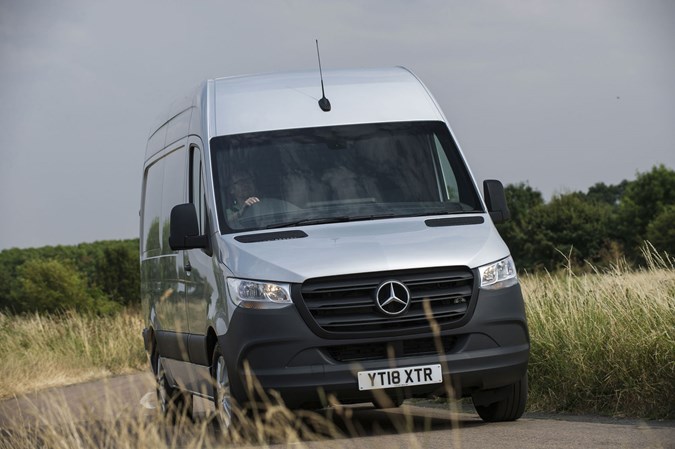
Most large vans are 3.5t vehicles, though higher and lower maximum laden mass ratings for these do exist. Those with ratings above 3.5t should be electronically limited to 56mph in order to be legal.
While small and medium vans will have lower maximum laden mass ratings than 3.5t – the Transit Custom goes up to 3.4t, but that is exceptionally high – the same van speed limit rules still apply.
You can find the exact maximum laden mass of your van on the weight plate. This is usually found under the bonnet, but your owner’s handbook will tell you where to find it on your specific vehicle.
Speed limits for car-derived vans and dual-purpose vehicles
Car-derived vans and dual purpose vehicles are the only light commercial vehicles allowed to travel at the same speed as cars:
| Built-up areas | Single carriageways |
Dual carriageways |
Motorways |
| 30mph | 60mph | 70mph | 70mph |
Remember, these are all subject to further restriction according to the speed limit signs, including those on variable speed limit motorways and smart motorways.
How do I know if I’m driving a car-derived van?
We have a full guide to car-derived vans (CDVs) which goes into all the legal definitions, but these are relatively easy to identify in the UK now, as they are quite literally passenger cars with the rear windows blanked out, the rear seats removed and the rear space converted into a load area.
Typically CDVs are based on small cars, as they have a maximum laden mass restriction of 2.0 tonnes. The most familiar examples are the Ford Fiesta Van and the Vauxhall Corsavan – though currently you can also get a Renault Zoe Van and a Dacia Duster Commercial.

All of these clearly have the bodywork and silhouette of the passenger car they are based on. Anything that has more extensive bodywork changes than blanked out rear side windows is unlikely to be a car-derived van.
As such, only if the logbook says ‘CDV’ are you legally allowed to drive at the same speeds as a car.
Dual-purpose vehicles are more complicated. So let’s start with the legal definition.
Legal definition of a dual-purpose vehicle
UK road traffic regulations tell us that dual-purpose means ‘a vehicle constructed or adapted for the carriage both of passengers and of goods and designed to weigh no more than 2,040kg when unladen.’
Note that’s the unladen weight, not the maximum laden mass we were talking about earlier. Unladen weight is defined by the government as the weight of the vehicle in road-going condition but without any fuel.
It must also have either four-wheel drive OR a rigid roof and at least one row of passenger seats behind the driver complete with side and rear windows – plus the correct ratio of passenger space to load area.
The government gives a full definition of dual-purpose vehicle requirements on its official legislative website.
This potentially covers a wide range of vehicles, including pickup trucks and commercial 4x4s as well as kombi and double-cab vans.
What are UK pickups speed limits?
Many pickups – especially popular double-cab pickups with four proper doors and five seats – count as dual-purpose vehicles, and can be driven as quickly as a car.
But you must check the unladen weight. For some high-spec pickups this will be greater than 2,040kg, which stops them being dual-purpose and restricts them to the same speeds as vans.

For example, Toyota always advises Hilux pickup buyers to abide by van speed limit rules and most Ford Rangers will be too heavy to travel at the same speeds as cars as well. The Isuzu D-Max, however, is light enough to count as a dual-purpose vehicle in every specification.
Important note: single-cab pickup trucks (those with only two doors and no second row of seats) without four-wheel drive are not considered dual-purpose, and can only drive at the same speed as vans.
>> Find out more about the best pickups in the UK
What are the speed limits for vans with side windows?
UK speed limit laws are not very clear when it comes to vans that are designed to carry passengers as well as goods.
Kombi (or combi) vans, double-cab vans and crew vans feature a second row of seats behind the driver. They can qualify for dual-purpose status in the same way as pickups – but only if they meet all the necessary requirements.
As such, they must have side windows and rear windows (not all crew vans come with them as standard), they must have the correct ratio of passenger space to load area, and they must have an unladen weight lower than 2,040kg (2.04 tonnes).
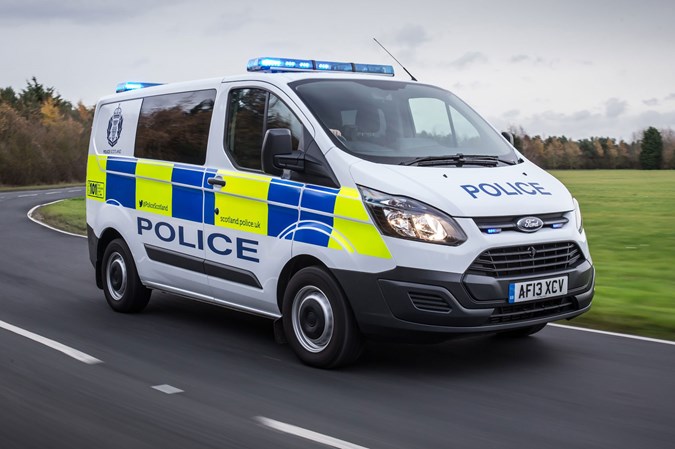
You can also look for ‘window van’ on the V5C logbook – but this will only make a difference if the van meets all the other requirements.
If you do feel you’ve been wrongly accused of speeding in a dual-purpose van, our best advice is to remain polite, explain your position clearly, and be prepared to appeal at a later date.
Aftermarket campervan conversions can often fall foul of the same speeding confusion, but you can find out more about this in our full guide to UK campervan speed limits.
How to avoid getting caught speeding in a van
If you’re worried about getting caught speeding in your van, here are a few top tips to keep in mind.
1. Pay attention – look out for changes in the speed limit, understand what speeds you’re allowed to go in the van on different roads
2. Use cruise control – cruise control is great for avoiding ‘speed creep’ as it keeps the vehicle at a constant speed. This is especially useful for roads covered by average speed cameras, which measure your speed between two points rather than at a single one
3. Use a speed limiter – these can be fixed or manually set. The latter is a good alternative to cruise control, as it can be adjusted but won’t allow the van to travel faster than the speed you’ve selected, and the van will still slow down when you take your foot off the accelerator (which cruise control won’t)
4. DON’T rely on sat-navs – satellite-navigation devices sometimes have built-in speed limit displays, but we’ve found that these are often out of date and don’t reflect the real limit, especially for commercial vehicles. Never rely on them
5. DON’T rely on dashboard displays – some new vans also have cameras that read road signs and display them on the dashboard. Unfortunately, these sometimes make mistakes, which can range from failing to spot a new limit to reading an incorrect number off the back of a truck and telling you the speed limit on the A14 is 90mph (this actually happened to us).
6. Be wary of ‘intelligent’ adaptive cruise control – some adaptive cruise control systems will now automatically adjust the cruise control speed based on road signs read by the on-board camera. Again, the problems come if the camera makes a mistake, and starts accelerating the vehicle when the speed limit hasn’t actually changed (this happened to us while travelling on a road covered by average speed cameras – oh, how we laughed…)
Van speed limit FAQs
What’s the speed limit when towing a trailer?
If you’re towing a trailer with your van or pickup the only difference in speed limit comes on the motorway, where you’re limited to 60mph instead of 70mph.
This is exactly the same speed limit for cars towing trailers.
Articulated vehicles are also subject to the 60mph motorway speed limit restriction.
What’s the difference between a motorway and a dual carriageway?
What is a dual carriageway? In the UK Highway Code, a dual carriageway is a road with a central reservation (barrier) between the two sides. Usually they have two lanes in either direction, but sometimes only one and sometimes more than two.
Regardless, the speed limit on a dual carriageway is just 60mph for vans, not the 70mph that cars are allowed to travel at. You can tell you’re on a dual carriageway by the main road signs for junctions, which will have a green background rather than the blue background used on motorway signs.
A motorway is a type of dual carriageway, but they have more particular requirements. Motorways usually have a hard shoulder (though newer ‘smart motorways’ have done away with this in favour of refuge areas), but more importantly they have very specific entrances and exits (junctions) that are always numbered.
Designed for fast, safe travel, motorways also restrict the types of vehicle that are allowed to go on them – pedestrians, cyclists, tractors and other slow moving vehicles are not allowed on the motorway.
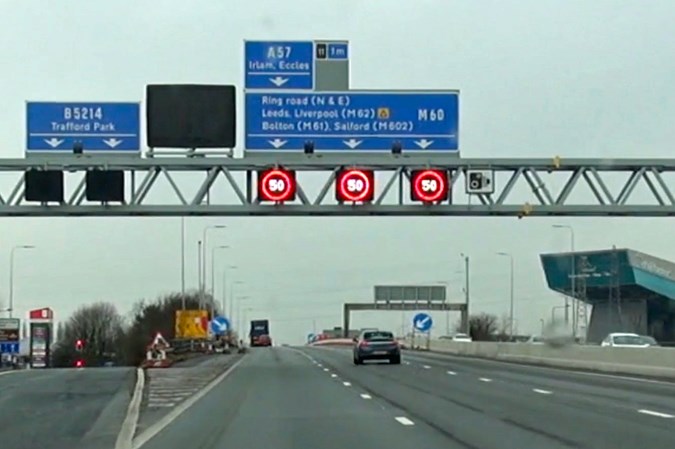
Indicated by an M in the road name and featuring blue road signs, motorways have a maximum speed limit of 70mph that applies to vans and cars (60mph if you’re towing a trailer).
However, many motorways (and some dual carriageways) now have variable speed limits, indicated by digital signs on overhead gantries that pass over the road. If you see these displaying a number lower than 70 on a white background surrounded by a red circle then that is the legal maximum speed for that stretch of road at that point in time.
The variable speed limit remains in place until you pass under another sign showing a different speed or the national speed limit sign. The national speed limit sign means the road has returned to its usual maximum limit.
What is the national speed limit sign?
The National Speed Limit is the maximum speed allowed on each type of road. Most roads in built-up areas have specifically numbered speed limit signs – 20, 30, 40 or 50 in a red circle, indicating the fastest you are allowed to travel, while county roads, dual carriageways and motorways typically use the national speed limit sign instead.
The national speed limit sign is a white circle with a black diagonal line from the top right to the bottom left. It’s also one of the most confusing roadsigns in the UK, as it stands for different speeds on different roads.
On a country lane, it means the maximum speed is 60mph for cars and 50mph for vans. On a dual carriageway it means 70mph for cars, 60mph for vans. And on the motorway it means 70mph for cars and vans.
What does maximum laden mass mean?
The term ‘maximum laden mass’ means the same as maximum authorised mass (MAM), revenue weight and gross vehicle weight (GVW).
All of these refer to the total legal weight of the vehicle with everything on board, including the people.
How much can you be fined for speeding?
While many speeding offences are dealt with by a Fixed Penalty Notice (FPN), if you go to court for speeding you can be fined up to 175% of your weekly salary.
This goes for cars as well as vans and pickups.
The fine is capped at £2,500 on the motorway, £1,000 on more minor roads, with the final value split into three bands, depending on how far over the limit you were caught.
Under Band A, the court can impose a fine in the range of 25-75% of your weekly salary. You will also receive three penalty points.
Band A speeding offences:
- > 21-30mph when the speed limit is 20mph
- > 31-40mph when the speed limit is 30mph
- > 41-55mph when the speed limit is 40mph
- > 51-65mph when the speed limit is 50mph
- > 61-80mph when the speed limit is 60mph
- > 71-90mph when the speed limit is 70mph
Under Band B, the range is 75-125% of your weekly salary, plus between four and six penalty points or disqualification from driving for seven to 28 days.
Band B speeding offences:
- > 31-40mph when the speed limit is 20mph
- > 41-50mph when the speed limit is 30mph
- > 56-65mph when the speed limit is 40mph
- > 66-75mph when the speed limit is 50mph
- > 81-90mph when the speed limit is 60mph
- > 91-100mph when the speed limit is 70mph
Under Band C the range is 125-175% of your weekly salary, plus six penalty points or a seven to 56-day driving ban.
However, the guidelines also explicitly state: ‘Where an offender is driving grossly in excess of the speed limit the court should consider a disqualification in excess of 56 days.’ So that’s not a set limit.
Band C speeding offences:
- > 41mph and above when the speed limit is 20mph
- > 51mph and above when the speed limit is 30mph
- > 66mph and above when the speed limit is 40mph
- > 76mph and above when the speed limit is 50mph
- > 91mph and above when the speed limit is 60mph
- > 101mph and above when the speed limit is 70mph
The ‘speed limit’ in all these cases should be considered the legal limit for the van, rather than the road.
Is it worse to get caught speeding in a van?
Frankly, yes. When announcing the guidelines above, the UK Sentencing Council that sets the fines and other penalties categorically confirmed that the type of vehicle will be taken into account.
As such, speeding in a van or other goods vehicle will be considered worse because the vehicle’s size and weight increases the potential danger involved in exceeding the legal limit.
Other things that will make a speeding offence more serious include the weather conditions, the number of people on board and the location – such as near a school, in traffic or where there are high numbers of pedestrians.
Should I rely on my sat-nav knowing the speed limit?
No. Speed limits often change more quickly than the databases used by satellite-navigation mapping services are updated. And they often don’t account for the type of vehicle being driven, either.
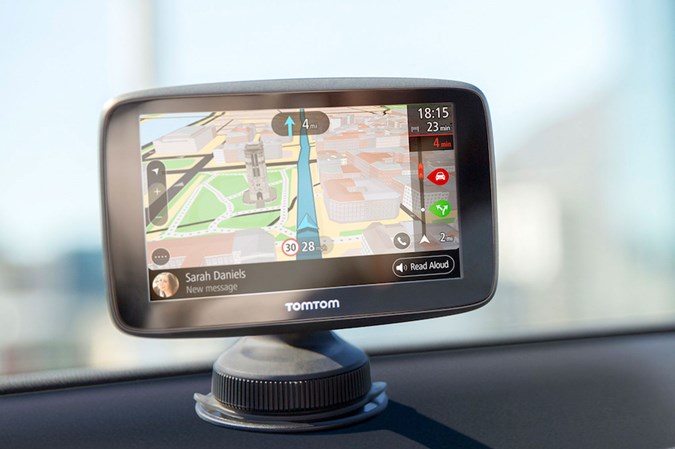
It is much better to rely on the physical speed limit signs. If in doubt, err on the side of caution.
The same goes for the new-fangled speed limit displays that are popping up in some modern cars and vans, which use cameras to read road signs and display them on the dashboard. These systems can – and frequently do – make mistakes.
Just so you know, we may receive a commission or other compensation from the links on this website - read why you should trust us.



